
Photo: Archiv LKN.SH. Bird covered with oil.
Oil pollution and seabirds
M. Schulz, D.M. Fleet, K.C.J. Camphuysen, M. Schulze-Dieckhoff & K. Laursen
Published 2017
(Version 1.01)
1. Introduction
Since the 1970s, beached oiled seabird cadavers have been monitored as indicators of oil pollution of marine waters (Camphuysen, 2010). Correlations were found between oil rates (the fraction of oiled seabirds washed ashore among the total number of dead birds found on beaches) of seabirds and the degree of oil pollution of the North Sea, although oil rates differed considerably between species. Declining trends of oil rates were observed for both, nearshore and offshore waters, but were much more pronounced in the former due to intensified pollution of coastal waters (Stienen et al., 2017). Nonetheless, until 2009 the OSPAR target of ecological quality objective (EcoQO), which requires that the oil rate among beached cadavers of Common Guillemots should be less than 10% over a five year period, was not achieved in Dutch North Sea and in Wadden Seas waters (Camphuysen, 2010).
Oils spills not only directly increase mortality of seabirds (Castège et al., 2004), sporadically locally in large numbers but also chronically, but may also have long-term impact on their diet (Moreno et al., 2013) and on demographic features due to age and sex-specific differences in mortality (Martínez-Abraín et al., 2006). In turn, long-term effects of major oil spill events and chronic oil pollution are discussed as potential reasons for declines in bird populations (Votier et al., 2005). These authors found that winter mortality of adult guillemots was doubled by major oil pollution incidents in combination with effects of the North Atlantic Oscillation (NAO). However, cumulative adverse effects on size and demography of seabird populations have seldom been quantified, which is due to the fact that population sizes of seabirds may even increase, although various pressures, such as declines in food availability and increases in abundances of marine litter, have become severe ecological problems in the North Sea and worldwide during the last decades (Camphuysen and Garthe, 2000; van Franeker et al., 2011).
The monitoring of beached oiled seabirds, as performed by the Netherlands, Germany and Denmark, in part since 1975, has become a valuable instrument for detecting changes in chronic oil pollution as a pressure on marine wildlife (Camphuysen and Heubeck, 2001). Other methods can be applied, such as vessel-based surveys combined with tracking data, to identify key marine areas for seabirds, which are sensitive to oil pollution (Louzao et al., 2009). However, sudden decreases in oil rates of beached seabirds could be related to environmental legislation and related measures implemented to reduce oil pollution (Lagring et al., 2012), which underlines the necessity to continue the monitoring of beached seabirds in order to assess the effectiveness of such measures and, where necessary, to implement further measures.
Conclusions of the 2009 Quality Status Report (QSR)
The results of beached bird surveys in the Wadden Sea area and its approaches in the period 2003/04-2007/08 indicated that oil rates had declined significantly over the last decades. The decline was most prominent in the Wadden Sea itself, whereas oil rates of birds found along North Sea shores (including the North Sea side of the Wadden Sea islands) were consistently higher than those in the Wadden Sea. Pelagic seabirds, notably Common Guillemots, still had relatively high oil rates and the designation of North West European waters as a Special Area under MARPOL Annex I in 1999 did not lead to a clear decline in oil contamination levels on beached birds on the coasts in the Wadden Sea region. For most inshore species, as exemplified by Shelduck, Common Eider and Herring Gull, oil rates were generally much lower than historical levels within the Wadden Sea. High oil rates for a number of species in Lower Saxony in the winter 2008/09 were a result of the Duncan Island oil incident. The effect of the designation of the PSSA Wadden Sea in 2002 is unclear, because, within the Wadden Sea, oil rates have always been lower than along the North Sea coasts. The decline in oil rates within the Wadden Sea was consistent with the overall decline in oil rates recorded in Western Europe, but generally slightly steeper.
2. Status and trends
Sources of pollution
Data on oil spills from aerial surveys in the regions of the Bonn Agreement were taken from its annual reports on aerial surveillance (BAASP, 2008, 2009, 2010, 2011, 2012, 2013, 2014). Data evaluation only considered confirmed oil spills. However, in the reports it is stated that ‘…the potential density of the observations varies significantly between Contracting Parties’ of the Bonn Agreement, because of variations in the size of national Exclusive Economic Zones (EEZ). Insofar, data derived from the above-mentioned reports are semi-quantitative and have to be assessed cautiously.
Two oil spills larger than 100 m3 were documented by Denmark in 2008 and 2010. In 2014, several moderate oil spills, due to the wreck of the ship Spyros Armanankis, were recorded in Dutch waters. However, this wreck was in the entrance of the Scheldt Estuary, and no contaminated birds were reported. All other observed oil spills were of minor extent with volumes smaller than 100 m3.
From 2008 to 2014, the number of oils spills decreased in marine waters of the Netherlands, Germany and Denmark (Figure 1), however, the temporal scatter was large. In the same period, also the total estimated volume of oil spills decreased considerably in the waters of the three countries (Figure 2). The observed decreases in the number and volume of oil spills correspond to significantly decreasing trends of oil rates of beached seabird cadavers at the Dutch, German and Danish coasts (Camphuysen, 2010). This correlation underpins the importance of oiled beached Guillemots as indicators of chronic oil pollution, as shown below.
Recorded slicks were clustered around the major shipping routes in the southern and in the south-eastern North Sea (BAASP, 2014). This spatial distribution is reflected by in the oil rates of beached seabird cadavers, both in the present and preceding reporting periods, and implies that discharges from ships have remained the principal source of oil pollution.
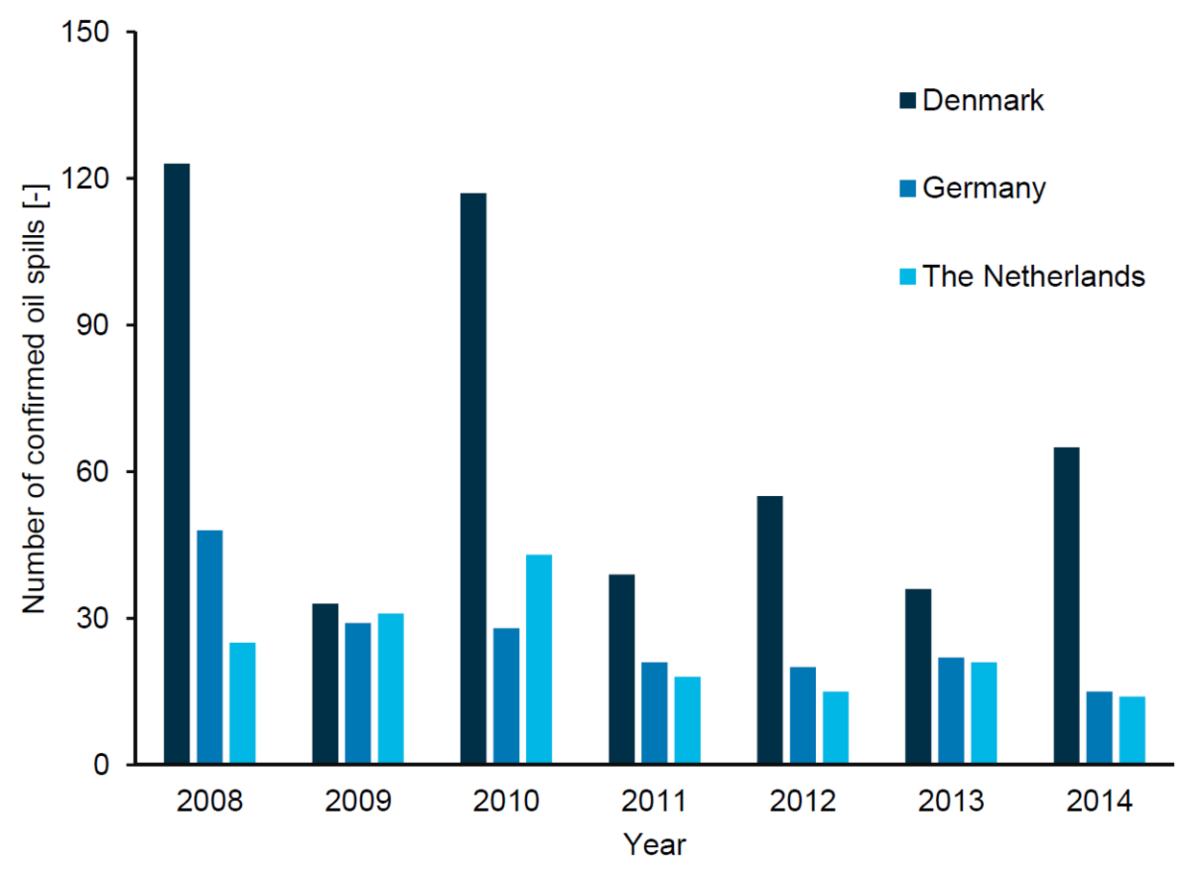 Figure 1. Total estimated numbers of confirmed oil spills in Dutch, German and Danish marine waters from 2008 to 2014 (Source: BAASP, 2008, 2009, 2010, 2011, 2012, 2013, 2014).
Figure 1. Total estimated numbers of confirmed oil spills in Dutch, German and Danish marine waters from 2008 to 2014 (Source: BAASP, 2008, 2009, 2010, 2011, 2012, 2013, 2014).
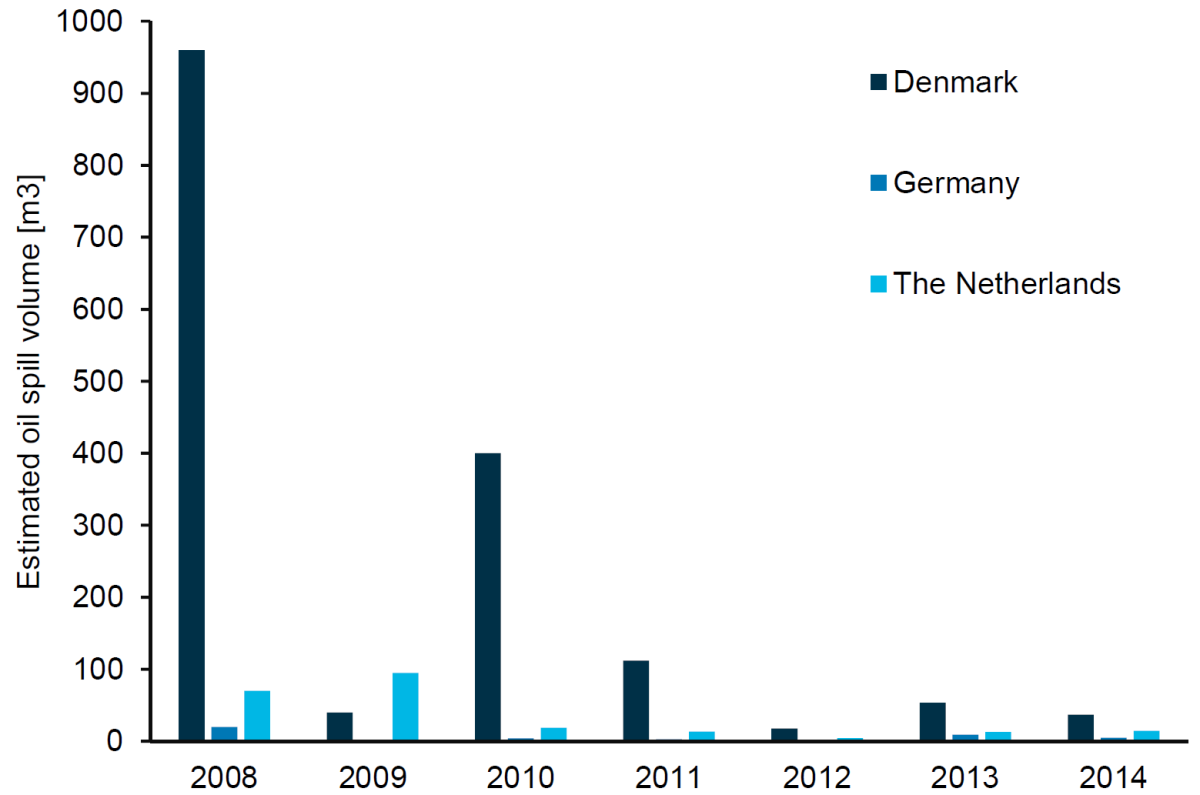 Figure 2. Total estimated volumes of confirmed oil spills in Dutch, German and Danish marine waters from 2008 to 2014 (BAASP, 2008, 2009, 2010, 2011, 2012, 2013, 2014).
Figure 2. Total estimated volumes of confirmed oil spills in Dutch, German and Danish marine waters from 2008 to 2014 (BAASP, 2008, 2009, 2010, 2011, 2012, 2013, 2014).
Oiled seabirds
Methods
A detailed description of the monitoring methods applied is given in Camphuysen and Heubeck (2001). Only information on oil contamination of intact cadavers were used in the subsequent analyses. Similar to the Wadden Sea Quality Status Report from 2009, data on oil rates of four species were considered for statistical analyses. These were Common Guillemot, Herring Gull, Shelduck, and Common Eider. For statistical analyses, the Danish, German and Dutch North Sea coast was subdivided into eight sub-regions. A distinction was made between (1) coasts exposed to the Wadden Sea (mainland coasts as well as island coasts facing the mainland) and (2) coasts exposed directly to the North Sea.
In Danish waters, surveys of beached birds following the method recommended by OSPAR started in winter 2004/05 and have been performed at four beaches. Three of these are situated along the North Sea coast (Skallingen, Fanø and Rømø) and one on the mainland coast (off Ribe). Data from the Danish coast were pooled, because here, the sample size was very small. Data from the Dutch North Sea coast starting in 1975/76 were subdivided into data from the mainland coast and data from beaches on the barrier islands. Surveys at the German coasts were initiated in 1992/93 and have been performed in two distinct sub-regions, the coast of Lower Saxony and the coasts of Schleswig-Holstein and Hamburg.
Descriptive statistics served to describe the degree of effects of chronic oil pollution on the marine avifauna. Non-parametrical analyses of variance (ANOVAs, Kruskal-Wallis-tests) were calculated, in order to identify significant temporal differences between oil rates in the current (2008/09 – 2015/16) and previous (2003/04 – 2007/08) reporting periods. ANOVAs were calculated for each species of each sub-region, so that in total 32 analyses were carried out. An additional ANOVA was calculated to detect if there was a significant difference between oil rates of the Dutch Wadden and North Seas, respectively.
Contrary to Camphuysen (2010), a non-parametrical method of time series analysis was applied, Mann-Kendall tests in combination with Sen-Theil slope estimations. These methods are advantageous compared to the transformation of data to logit values and subsequent linear regression analyses on the transformed data, because non-parametrical analyses are applicable to all frequency distributions of data. Furthermore they are robust against outliers. Therefore, tests for normality and outliers could be omitted before time series analyses. Time series analyses were calculated for each of the selected species for each sub-region, so that there were a total of 32 analyses.
In addition, cluster analyses were performed, in order to detect differences and similarities in trends and degrees of pressure of oil pollution on the four selected species. The Danish time series were excluded from the input data of cluster analyses, because otherwise the number of complete datasets would have been too low. Combinations of the algorithm Complete Linkage and Pearson-correlation coefficients as measures of proximity served to cluster time series according to similar data profiles (i.e. similar trends). Additional combinations of the algorithm Ward and Euclidean Distances as measures of proximity were applied, to cluster time series according to similar degrees of pollution (i.e. similar average oil rates). From these analyses both, regional differences and differences between the risk of different species to be contaminated by oil pollution, could be identified and discussed.
Current state
In 2009, a cooperation between several parties how to deal with oil contaminated birds has started to exist in the Netherlands, the so-called “Samenwerkingsregeling opvang Besmeurde Vogels (SBV)”.
In Table 1, descriptive statistics of oil rates between 2008/09 and 2015/16 are summarized. Common Guillemots had the highest oil rates, in parts of the Wadden Sea, of more than 30 %. Herring Gulls showed considerably lower oil rates ranging between 0.0 and 4.2 %. Oil rates of Shelducks and Common Eiders were even lower and were mostly 0.0 % or close to 0.0 %. For Common Guillemots at the Dutch and Danish coasts, the EcoQO, an oil rate of 10% or less, has not yet been achieved, although an overall decline in oil rates since the mid-1980s is obvious (Figure 3). However, at the German coasts, the EcoQO was achieved. Differences in oil rates between species are due to their behaviour as well as to their differing spatial distribution at sea: Common Guillemots, which live on the water surface and dive for food, revealed, as offshore seabirds, the highest oil rates, because ship traffic and oil spills are more frequent along main shipping routes distant from the coast than in coastal waters.
Beaches at the Dutch coast had the highest oil rates, especially concerning Common Guillemots. In the Netherland, oil rates of Common Guillemots were slightly lower in the Wadden Sea than in the North Sea, but this difference was not significant (p = 0.319, n = 37). At the German coasts, no such differences existed, because here in general, oil rates approximated to 0.0 %. The observed lower oil rates in the Dutch Wadden Sea in comparison to the Dutch North Sea can most likely be attributed to the predominant type of ships, which use Wadden Sea, which are considerably smaller and which do not generally use heavy fuel oil. Overall in the period 2008/09 to 2015/16, oil rates were lower than in the preceding reporting period 2003/04 to 2007/08, however, these differences were mostly not significant (see Annex, Table A1).
Table 1: Descriptive statistics of oil rates between 2008/09 and 2015/16.
Trends
With the exception of Denmark, all time series analyses gave significantly decreasing trends of oil rates (Table 2). The Danish time series did not reveal significant trends, because the number of replicates was low. For some species regional trends could not be calculated, due to high numbers of ties and zero values of input data. Maximum slope values amounted to -3.28 for Common Guillemot at the Wadden Sea coast of Lower Saxony. In general, slope values of Common Guillemots were higher than those of other species, which is probably attributable to the fact that Common Guillemots forage in offshore regions and therefore are more exposed to oil pollution compared to the other species. The observed decreases in oil pollution are mostly reflected by offshore species (Figure 3).
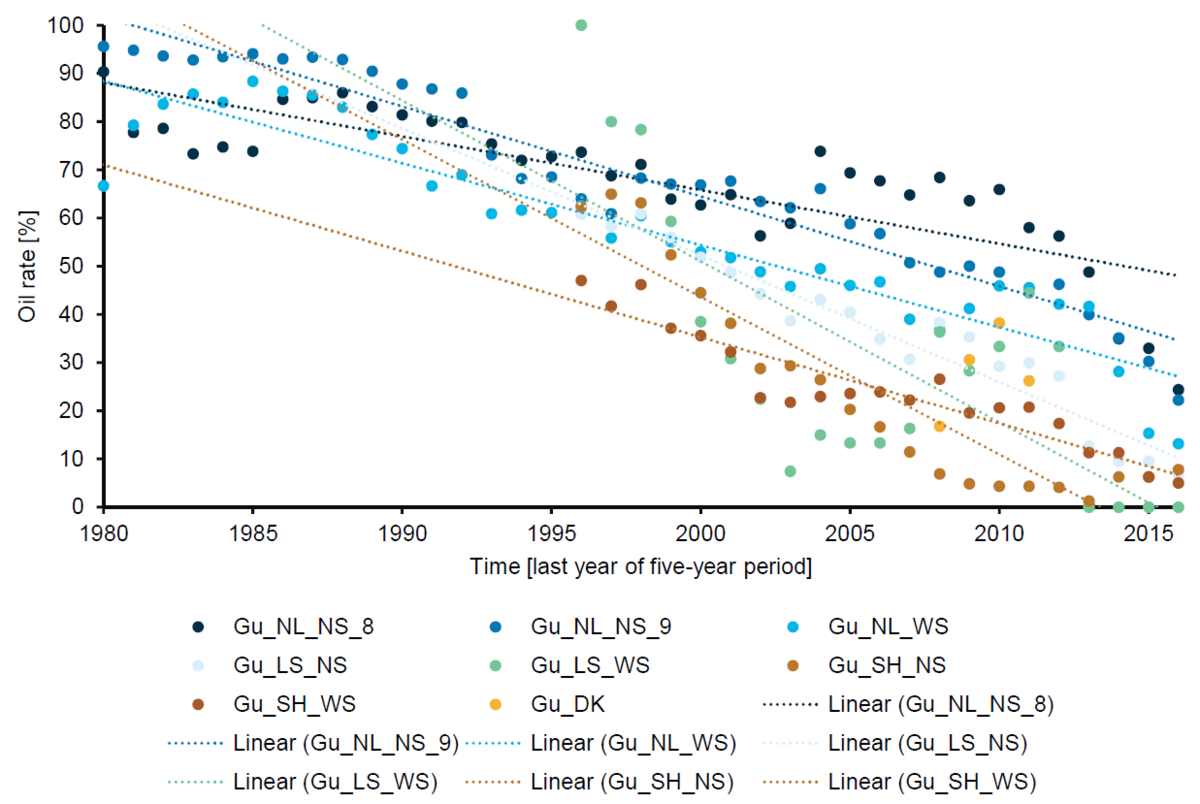 Figure 3. Trend plots of five-year-running means of oil rates of Common Guillemots against time. Trend lines (‘Linears’) are given for each regional time series in the same colour as data points of respective time series. For explanation of time series codes see Table 1.
Figure 3. Trend plots of five-year-running means of oil rates of Common Guillemots against time. Trend lines (‘Linears’) are given for each regional time series in the same colour as data points of respective time series. For explanation of time series codes see Table 1.
Table 2. Summary of results of time series analyses of oil rates from 1975/76 to 2015/16.
Differences between species and regions
Applying Pearson-correlation coefficients as measures of proximity, time series of oil rates were generally clustered by regions, namely by the Wadden and North Seas (Figure 4). Accordingly, trends mainly differed between the Wadden and North Seas rather than between species, which is potentially a result of regionally different protection measures (Camphuysen, 2010; Lagring et al., 2012). In 2002, the Wadden Sea was designated as a Particularly Sensitive Sea Area (PSSA) by the International Maritime Organization (IMO) (Reineking, 2002). Therefore, conservation measures have been intensified in this area, which probably have caused more pronounced decreasing trends of oil rates than in the North Sea.
Applying Euclidean distances as measures of proximity, time series of oil rates were clustered in two groups, where the first group mainly comprised time series of Common Guillemots and the second group time series of the other three species (Figure 5). By usage of Euclidean distances, differences of oil rates between species were therefore more pronounced than differences between regions. Thus, Common Guillemots are once again highlighted as the species most exposed to oil spills, because of their distribution in offshore regions, where dense ship traffic prevails.
Figure 4. Dendrogram resulting from a cluster analysis applying the algorithm Complete Linkage together with Pearson-correlation coefficients as measure of proximity to time series of oil rates [%]. The dimension of the x-axis is [1 – Pearson-r]. For descriptions of time series codes on the y-axis see Table 1.
![Dendrogram resulting from a cluster analysis applying the algorithm Ward together with Euclidean distances as measures of proximity to time series of oil rates [%]. Dendrogram resulting from a cluster analysis applying the algorithm Ward together with Euclidean distances as measures of proximity to time series of oil rates [%].](/sites/default/files/styles/inline_image_full_width_with_lightbox/public/qsr2016_oil%20polution%20and%20seabirds_figure5-graph.png?itok=z8s5rFja) Figure 5. Dendrogram resulting from a cluster analysis applying the algorithm Ward together with Euclidean distances as measures of proximity to time series of oil rates [%]. The dimension of the x-axis is (oil rates [%]). For descriptions of time series codes on the y-axis see Table 1.
Figure 5. Dendrogram resulting from a cluster analysis applying the algorithm Ward together with Euclidean distances as measures of proximity to time series of oil rates [%]. The dimension of the x-axis is (oil rates [%]). For descriptions of time series codes on the y-axis see Table 1.
3. Assessment
A specific target regarding beached oiled birds has not been formulated in the Wadden Sea Plan until now. However, the OSPAR EcoQO, as described above, can be applied and evaluated. Although an overall decline in oil rates since the mid-1980s is obvious, the Ecological Quality Objective (EcoQO) of an oil rate of less than 10% in common guillemots has not yet been reached in Dutch and Danish, but in German waters.
4. Recommendations
It is highly recommended to continue the monitoring of beached seabirds in all three Wadden Sea countries, in order to identify trends as potential indicators of the success of measures implemented to reduce oil pollution (Lagring et al., 2012). The prolongation of the present time series will lead to more reliable statistical analyses, because it will increase the statistical power of the data. For the same reason, monitoring of beached seabirds should continue covering the entire winter period from November to April. Thus, this will reduce the inconsistency in resulting data. Harmonization of the frequencies of surveys in the Netherlands, Germany and Denmark is desirable.
In addition to the designation of marine waters as Special Areas, concrete measures, such as intensified policing of coastal and offshore waters, are necessary for a sustained reduction of oil pollution. Amongst others, the following measures concerning pollution prevention as well as control and enforcement measures would help to reduce chronic oiling as a threat to marine wildlife:
- Mandatory on-board transponders and oil fingerprinting of all vessels in North Sea waters would facilitate surveillance, enforcement and the prevention of pollution;
- Harmonization and implementation of the EC Directive 2000/59/EC on port reception facilities, including 100% indirect financing of waste collection;
- Implementation of a ship accreditation system for skippers who promote and adopt best environmental practices and have clean environmental records;
- Stronger legal deterrence. Imposed (minimum) fines must be increased to clearly reflect the full extent of the crimes under both shipping and environmental laws.
Such measures should not only be restricted to PSSAs, such as the Wadden Sea, but should be extended to other sensitive areas, which for example can be identified by vessel-based surveys combined with tracking data (Louzao et al., 2009).
In the Wadden Sea region, the use of decision support systems (DSS) should be considered for optimising aerial surveillance and protection measures dealing with oil pollution.
Finally in harbours and marinas, as well as in training courses, education of ship crews and officers, in order to promote the awareness that illegal oil discharges are a criminal act not only according to jurisdiction, but also on marine wildlife, is imperative.
5. Summary
Chronic oil pollution is a persisting threat to marine wildlife. Oil spillage is mainly attributable to discharges from ships, as evidenced by spatial patterns of detected oil spills in the North Sea as well as chemical analysis of oil found on the coast (Fleet & Reineking 2001). Among four seabird species, Common Guillemots had the highest oil rates, in some cases of more than 30% in the period from 2008/09 to 2015/16. Herring Gulls, Shelducks and Common Eiders were rarely victims of oil pollution, due to the fact that these species are mainly distributed in coastal areas rather than in offshore regions, where the density of oil spillage is high. All species revealed significantly decreasing trends in oil rates since the beginning of beached bird monitoring, corresponding to decreasing numbers and volumes of oil slicks in the North and Wadden Seas. A comparison of trends by cluster analysis identified different temporal patterns in the North and Wadden Seas, with steeper decreases in oil rates in the Wadden Sea. It remains an open point of discussion, whether this difference is a result of reinforced protection measures in the Wadden Sea, which has been a PSSA since 2002. A comparison of average values of oil rates highlighted the Common Guillemot as one of the species most exposed to oil pollution, because of their winter distribution in offshore regions.
About the authorsM. Schulz1, D.M. Fleet2, K.C.J. Camphuysen3, M. Schulze-Dieckhoff4, K. Laursen5 1 University Osnabruck, Neuer Graben 29 / Schloss, 49074 Osnabrück, DE 2 The Schleswig-Holstein Agency for Coastal Defence, National Park and Marine Conservation, National Park Authority, Schlossgarten 1, 25832 Tönning, DE 3 Royal Netherlands Institute for Sea Research (NIOZ), Korringaweg 7, 4401 NT Yerseke, NL 4 Lower Saxon State Department for Waterway, Coastal and Nature Conservation (NLWKN), Am Sportplatz 23, 26506 Norden, DE 5 Aarhus University, Nordre Ringgade 1, 8000 Aarhus C, DK |
References
Bonn Agreement Aerial Surveillance Programme (BAASP) (2008) Annual report on aerial surveillance for 2008: 31 pp.
Bonn Agreement Aerial Surveillance Programme (BAASP) (2009) Annual report on aerial surveillance for 2009: 35 pp.
Bonn Agreement Aerial Surveillance Programme (BAASP) (2010) Annual report on aerial surveillance for 2010: 35 pp.
Bonn Agreement Aerial Surveillance Programme (BAASP) (2011) Annual report on aerial surveillance for 2011: 31 pp.
Bonn Agreement Aerial Surveillance Programme (BAASP) (2012) Annual report on aerial surveillance for 2012: 37 pp.
Bonn Agreement Aerial Surveillance Programme (BAASP) (2013) Annual report on aerial surveillance for 2013: 48 pp.
Bonn Agreement Aerial Surveillance Programme (BAASP) (2014) Annual report on aerial surveillance for 2014: 61 pp.
Camphuysen K. C. J. (2010) Declines in oil-rates of stranded birds in the North Sea highlight spatial patterns in reductions of chronic oil pollution. Marine Pollution Bulletin 60: 1299–1306.
Camphuysen K. C.J. and Garthe S. (2000) Seabirds and commercial fisheries: population trends of piscivorous seabirds explained? In: Kaiser M.J. and Groot S.J. de, (Eds.). Effects of fishing on non-target species and habitats: Biological, Conservation and Socio-Economic Issues, Blackwell Science, Oxford: 163-184.
Camphuysen C. J. & Heubeck M. (2001) Marine oil pollution and beached bird surveys: the development of a sensitive monitoring instrument. Environmental Pollution 112: 443-461.
Castège I., Hémery G., Roux N., d’Elbée J., Lalanne Y., D’Amico F. & Mouchès C. (2004) Changes in abundance and at-sea distribution of seabirds in the Bay of Biscay prior to, and following the “Erika” oil spill. Aquatic Living Resources 17: 361–367.
Fleet D. M. Reineking B. (2001) Bestimmung, Quantifizierung und Bewertung der Öleinträge in der Nordsee zur Beurteilung der Schiffsentsorgung in deutschen Nordseehäfen. UBA Berlin, FKZ 297 25 310, Hochschule Bremen, pp. 279.
Lagring R., Degraer S., de Montpellier G., Jacques T., Van Roy W., Schallier R. (2012) Twenty years of Belgian North Sea aerial surveillance: A quantitative analysis of results confirms effectiveness of international oil pollution legislation. Marine Pollution Bulletin 64: 644–652.
Louzao M., Bécares J., Rodríguez B., Hyrenbach K. D., Ruiz A. & Arcos J. M. (2009). Combining vessel-based surveys and tracking data to identify key marine areas for seabirds. Marine Ecology Progress Series 391: 183-197.
Martínez-Abraín A., Velando A., Oro D., Genovart M., Gerique C., Bartolomé M. A., Villuendas E. & Sarzo B. (2006). Sex-specific mortality of European shags after the Prestige oil spill: demographic implications for the recovery of colonies. Marine Ecology Progress Series 318: 271-276.
Reineking B. (2002). The Wadden Sea designated as a PSSA. Wadden Sea Newsletter 2002, 2: 10-12.
Stienen E. W.M., Courtens W., Van de Walle M., Vanermen N., Verstraete H. (2017) Long-term monitoring study of beached seabirds shows that chronic oil pollution in the southern North Sea has almost halted. Marine Pollution Bulletin, 115: 194-200.
Van Franeker J. A., Blaize C., Danielsen J., Fairclough K., Gollan J., Guse N., Hansen P.-L., Heubeck M., Jensen J.-K., Le Guillou G., Olsen B., Olsen K.-O., Pedersen J., Stienen E. W. M. & Turner D. M. (2011). Monitoring plastic ingestion by the northern fulmar Fulmarus glacialis in the North Sea. Environmental Pollution 159: 2609-2615.
Votier S. C., Hatchwell B. J., Beckerman A., McCleery R. H., Hunter F. M., Pellatt J., Trinder M. & Birkhead T. R. (2005). Oil pollution and climate have wide-scale impacts on seabird demographics. Ecology Letters 8: 1157–1164.
This report should be cited as: Schulz M., Fleet D.M., Camphuysen K.C.J., Schulze-Dieckhoff M. & Laursen K. (2017) Oil pollution and seabirds. In: Wadden Sea Quality Status Report. Eds.: Kloepper S. et al., Common Wadden Sea Secretariat, Wilhelmshaven, Germany. Last updated 01.03.2018. Downloaded DD.MM.YYYY. qsr.waddensea-worldheritage.org/reports/oil-pollution-and-seabirds
All 2017 reports may be cited collectively as: Kloepper S., Baptist M. J., Bostelmann A., Busch J.A., Buschbaum C., Gutow L., Janssen G., Jensen K., Jørgensen H.P., de Jong F., Lüerßen G., Schwarzer K., Strempel R. & Thieltges D. (2017) Wadden Sea Quality Status Report. Common Wadden Sea Secretariat, Wilhelmshaven, Germany. Downloaded DD.MM.YYYY. qsr.waddensea-worldheritage.org

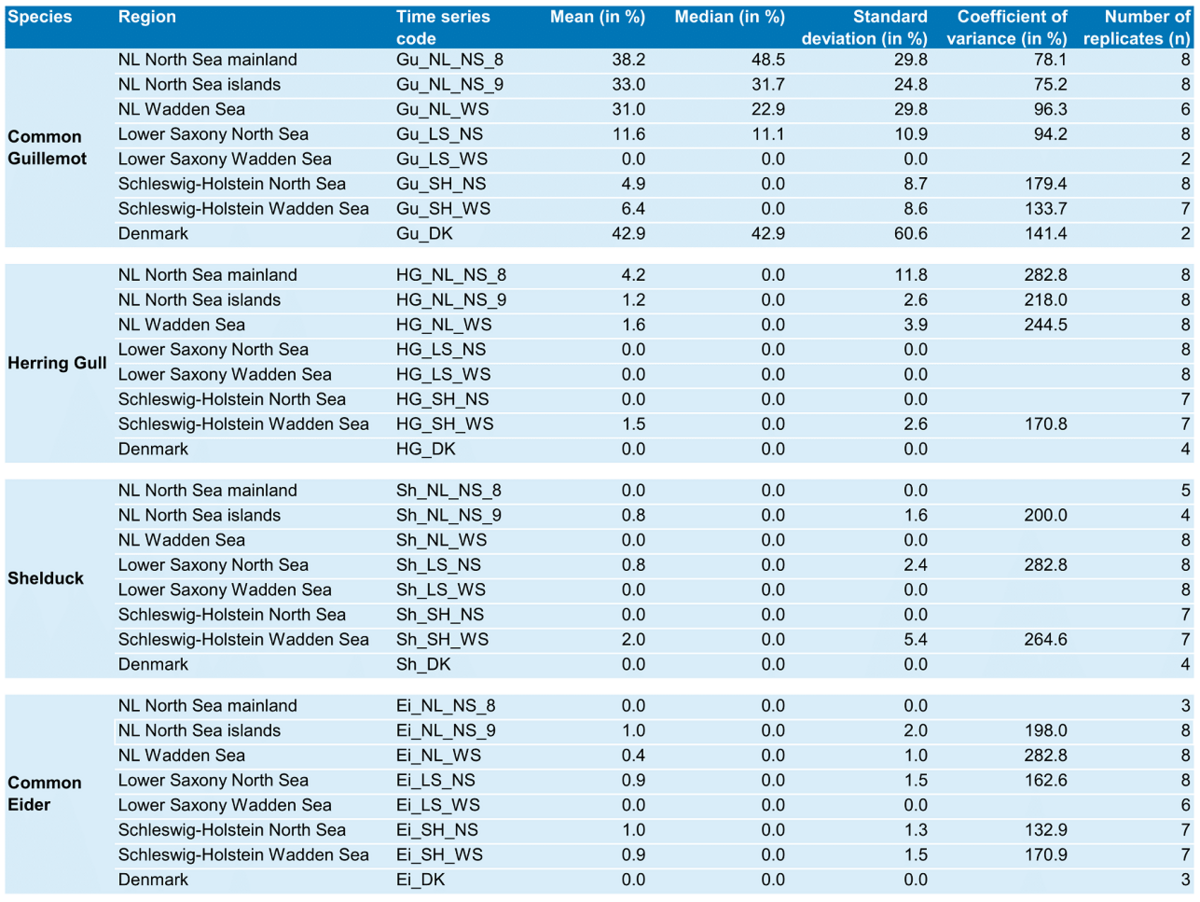
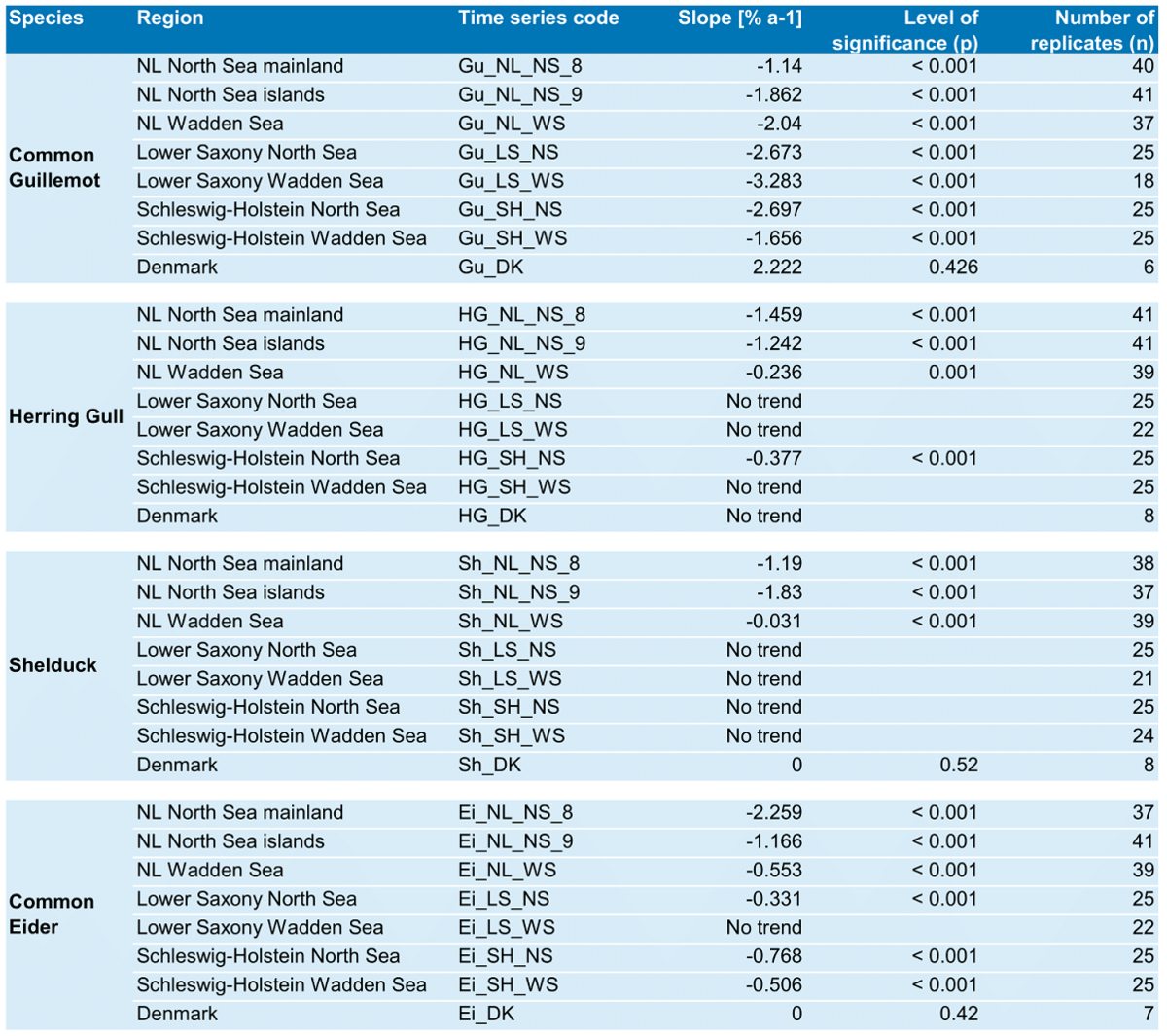
![Dendrogram resulting from a cluster analysis applying the algorithm Complete Linkage together with Pearson-correlation coefficients as measure of proximity to time series of oil rates [%] Dendrogram resulting from a cluster analysis applying the algorithm Complete Linkage together with Pearson-correlation coefficients as measure of proximity to time series of oil rates [%]](/sites/default/files/styles/inline_image_full_width_with_lightbox/public/qsr2016_oil%20polution%20and%20seabirds_figure4-graph.png?itok=PoBiELMu)